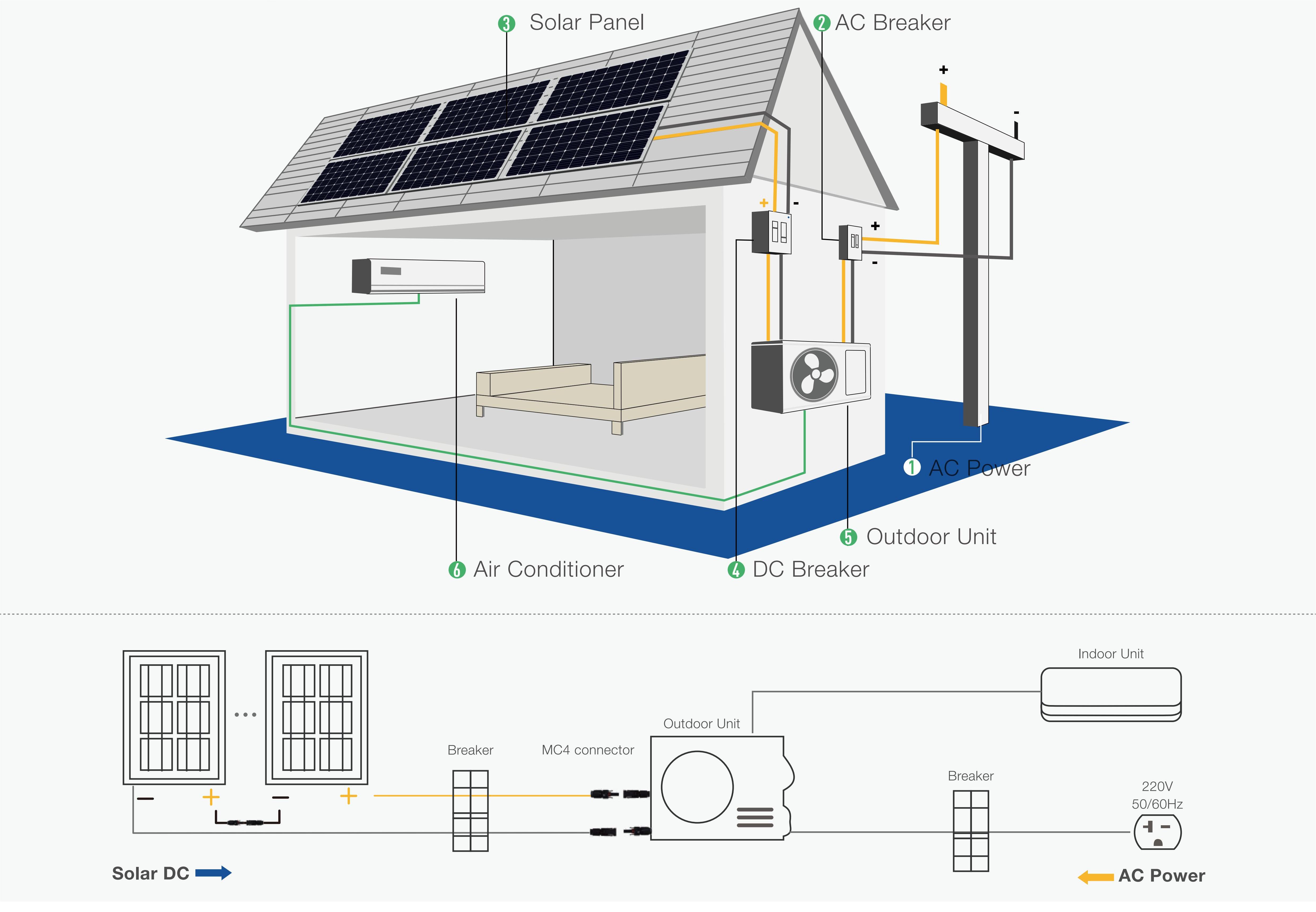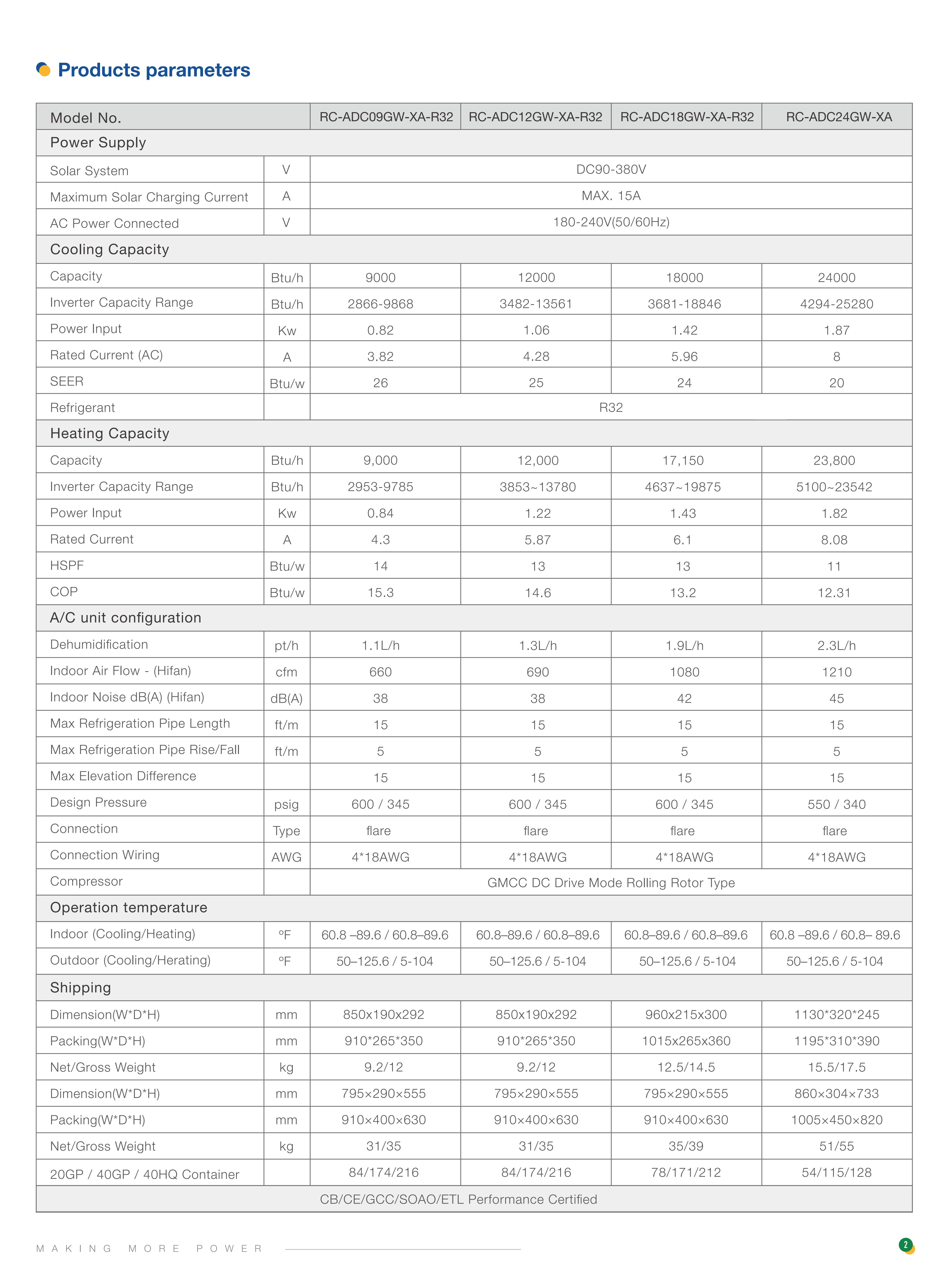A solar-powered air conditioner is an air conditioning system that operates using solar energy. It harnesses the power of the sun to generate electricity needed for cooling without relying on the traditional electrical grid.
Solar panel voltage:
DC90-380VMaximum Solar Charging Current:
15AAC Power Connected:
180-240V(50/60Hz)Refrigerant:
R32Compressor:
GMCC DC Drive Mode Rolling Rotor TypeConnection:
Flare
The basic components of a solar-powered air conditioner include solar panels, an inverter, a compressor, and an air conditioning unit.
Here's how it generally works:
1. Solar panels: Photovoltaic (PV) solar panels are installed on the roof or any suitable location where they can receive maximum sunlight. These panels convert sunlight into direct current (DC) electricity.
2. Inverter: The DC electricity produced by the solar panels is fed into an inverter, which converts it into alternating current (AC) electricity. AC electricity is the type of electricity used by most appliances in homes and businesses.
3. Compressor: The AC electricity generated by the inverter powers the compressor in the air conditioning system. The compressor is responsible for compressing the refrigerant gas, which raises its temperature.
4. Air conditioning unit: The compressed refrigerant gas is then circulated through the air conditioning unit, which extracts heat from the indoor air and transfers it to the refrigerant. Cool air is then blown into the room, while the heated refrigerant releases the heat to the outside.

Advantages of solar-powered air conditioners include reduced electricity bills, lower carbon footprint, and increased energy independence. However, there are a few considerations to keep in mind:
1. Solar panel capacity: Sufficient solar panel capacity is required to generate enough electricity to power the air conditioning system. The number of panels and their efficiency will depend on factors such as the size of the air conditioner and the local sunlight availability.
2. Energy storage: Solar-powered air conditioners may need an energy storage system, such as batteries, to store excess solar energy generated during the day for use during the night or when sunlight is unavailable.
3. System efficiency: Solar-powered air conditioners may have lower energy efficiency than conventional air conditioners, which could affect their cooling capacity. It's important to consider the system's efficiency ratings when choosing a solar-powered air conditioner.
4. Installation and maintenance: Proper installation and regular maintenance are essential for optimal performance. It's recommended to consult with professionals experienced in solar air conditioning installations.
Solar-powered air conditioners offer a greener and more sustainable cooling solution, allowing you to utilize renewable energy from the sun to power your cooling needs.

Global Market Of Solar Air Conditioning:
Solar air conditioners have gained popularity in recent years as a sustainable and energy-efficient alternative to traditional air conditioning systems. These systems utilize solar energy to power air conditioning process, reducing the reliance on grid electricity and minimizing carbon emissions.
The market for solar air conditioners has been growing steadily, driven by factors such as increasing energy costs, environmental concerns, and government incentives promoting the use of renewable energy. However, the market penetration of solar air conditioners varies across different regions due to factors like climate, energy infrastructure, and consumer awareness.
Key market players in the solar air conditioner industry include established HVAC (Heating, Ventilation, and Air Conditioning) manufacturers and specialized solar energy companies. These companies offer a range of solar air conditioning solutions, including both central and decentralized systems for residential, commercial, and industrial applications.
China has been one of the leading markets for solar air conditioners, driven by its large population, government support for renewable energy, and a high demand for cooling solutions. Other regions with a significant market presence include the United States, India, Australia, and parts of Europe.
It's worth noting that the solar air conditioner market is dynamic and subject to changes in technology, government policies, and consumer preferences. For the most up-to-date information and specific market figures, I recommend consulting market research reports or industry publications that focus on energy-efficient technologies and renewable energy systems.
FAQs:
Q1: Do you support OEM/ODM?
A:Definitely, OEM&ODM service is supported with a certain quantity,including customize logo,package and label;
Q2: What's the production time?
A: The production time is normally 15 working days. but we will always prepare some stocks for popular models.
Q3: Can you provide DDP service?
A:Yes, if you are a personal customer and don't want to deal with the customs, we can provide DDP service to your address.
Q4: What about the warranty and how to claim?
A: Warranty period are 5 years since you receive the product, our professional after-sales team will deal with all warranty issues.